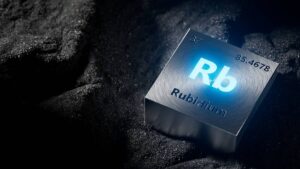Revolutionising rubidium: How direct extraction tech can be used beyond lithium

On November 28 the price of rubidium carbonate was US$1205/kg. Pic: Getty Images.
- Perth’s Edith Cowan University and Everest Metals investigating membrane tech at Mt Edon rubidium project
- Metal commands crazy high prices due to widespread use in military and energy tech
- Direct extraction tech could have applications for minerals beyond lithium
Rubidium is a critical element for various high-tech military, energy tech and biomedical applications, and could now be processed in the same fashion as direct lithium extraction.
It’s a critical and/or strategic mineral for the US and Japan due to its use in military, new energy and high-tech applications such as night vision equipment, radiation detection, infrared signals, thin batteries, vapour turbines and in ion engines that could power spacecraft.
In communications, it’s used in ion cloud communications and fibre optics. In the medical field, its uses are in sedatives, tranquilisers and medications for treating epilepsy.
That’s on top of specialty glass, where rubidium enhanced its conductivity, lifespan and stability and even gives fireworks a purple colour.
And the price is astronomical.
As of November 28, the price for 99%+ purity rubidium carbonate was US$1205/kg, which equates to around US$1.205 million per metric tonne.
Compare that to 99.2% pure lithium carbonate at US$10,319.14/t, and rubidium’s rarity has it trading at 116x the value.
Despite actually being more abundant than zinc or copper in the Earth’s crust, and being typically found in hard rock pegmatites like lithium, rubidium’s production currently only sits between 2-4 tonnes per annum, according to the United States Geological Survey.
A technical breakthrough right here in Australia though could make it easier to process and extract, with researchers from Perth’s Edith Cowan University’s Mineral Recovery Research Centre successfully demonstrating the direct extraction of rubidium from ore samples supplied by Everest Metals (ASX:EMC).
Environmentally friendly extraction
The tech has been around for years in water treatment, and in recent years lithium brine players have chased the promise of the more environmentally friendly extraction method.
It works by pumping brine into a tank where ion exchange beads latch onto the lithium and then the remaining water is then recycled (sans lithium) back into the aquifer.
Originally the plan was to follow the route for lithium production only at the company’s Mt Edon project in WA.
However, ECU Associate Professor Amir Razmjou says the team soon realised that the ion exchange process could be applied to a range of minerals.
“While we were initially approached to look at lithium extraction at Mt Edon, further evaluation revealed that the Mt Edon deposit has a high content of rubidium,” he said.
“Our discussions then progressed to involve the extraction of rubidium, with lithium as a by-product.”
Traditional mineral processing is very energy and water intensive, using a leaching process, but Professor Razmjou says direct extraction offers a range of environmental and economic benefits.
“We can selectively extract rubidium from the resource or deposit that we have and recycle the water back into the process,” he said.
“The idea was also to design a process that has a very small amount of reagents too.
“We wanted to design a process that has a low water consumption rate, a low water footprint and modularity which allows the copy and paste of the process easily.”
Modular format allows scale up
It’s that copy and paste that will allow EMC to scale up as required.
Earlier this year, the company delivered a rubidium resource of 3.6Mt at 0.22% rubidium and 0.07% Li2O for the project, which included a high-grade zone of 1.3Mt at 0.33% rubidium and 0.07% Li2O.
“Rubidium is a critical mineral which plays a significant and growing role in national security, healthcare and emerging energy applications. Rubidium currently has a small global market, but this has been driven by supply constraints rather than demand,” EMC executive chairman Mark Caruso said back in August.
The company is aiming to release a scoping study in Q1 CY25, along with the ongoing rubidium extraction and purification testwork with the help of the MRC.
Pilot plant plans for 2025
There’s also a pilot plant in the works, with the goal of the project to prove up the commercialisation potential of the process by showing its technically and economically feasible.
Over the coming months, the ECU researchers will undertake purification work on the rubidium extracted to date. The next stop after that is a demonstration plant.
“We’re finalising our study on the direct rubidium extraction technology to optimise the process, and hopefully early next year we will have enough data to go forward with the pilot plant for rubidium extraction,” Professor Razmjou said.
The membrane technology can also be expanded to other minerals, with MRRC also working with Impact Minerals (ASX:IPT) to extract high purity alumina at its Lake Hope project in WA. But that’s a story for another day.
“I think the technology that we are developing at ECU with the modular ability to scale up is disruptive,” Professor Razmjou said.
“These new technologies could revolutionise the mining industry.”
EMC share price today:
Which other ASX players have rubidium?
There are scant plays on the ASX focused purely on rubidium like EMC, but several companies have a mix of lithium-rubidium-tantalum – as the elements often occur together.
One notable explorer is Aldoro Resources (ASX:ARN), who back in 2021 announced an inferred resource estimate for the Niobe project in WA of 4.615Mt at 0.17% rubidium and 0.07% lithium.
The company is currently aiming to progress the transition of the Niobe tenement from a Prospecting Licence (P57/2137) to granted Mining Licence (M59/775).
Other companies with a smattering of rubidium include Raiden Resources (ASX:RDN), who have found some at the Andover South lithium project in WA, likewise Aruma Resources’ (ASX:AAJ) Mt Deans project, also in WA, is host to both lithium and rubidium and Infinity Mining’s (ASX:IMI) Woody Project (formerly Tambourah South) flagged a hit of 1m at 2.1% lithium, 1,060ppm rubidium, 119ppm caesium and 80ppm tantalum from 31m.
ARN, RDN, AAJ, and IMI share prices today:
At Stockhead, we tell it like it is. While Everest Metals, Impact Minerals and Raiden Resources are Stockhead advertisers, they did not sponsor this article.
Related Topics

UNLOCK INSIGHTS
Discover the untold stories of emerging ASX stocks.
Daily news and expert analysis, it's free to subscribe.
By proceeding, you confirm you understand that we handle personal information in accordance with our Privacy Policy.








